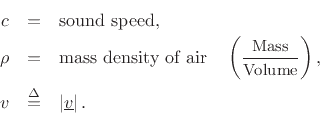Next |
Prev |
Up |
Top
|
Index |
JOS Index |
JOS Pubs |
JOS Home |
Search
Acoustic intensity may be defined by
where
For a plane traveling wave, we have
where
is called the wave impedance of air, and
Therefore, in a plane wave,
Next |
Prev |
Up |
Top
|
Index |
JOS Index |
JOS Pubs |
JOS Home |
Search
[How to cite this work] [Order a printed hardcopy] [Comment on this page via email]





